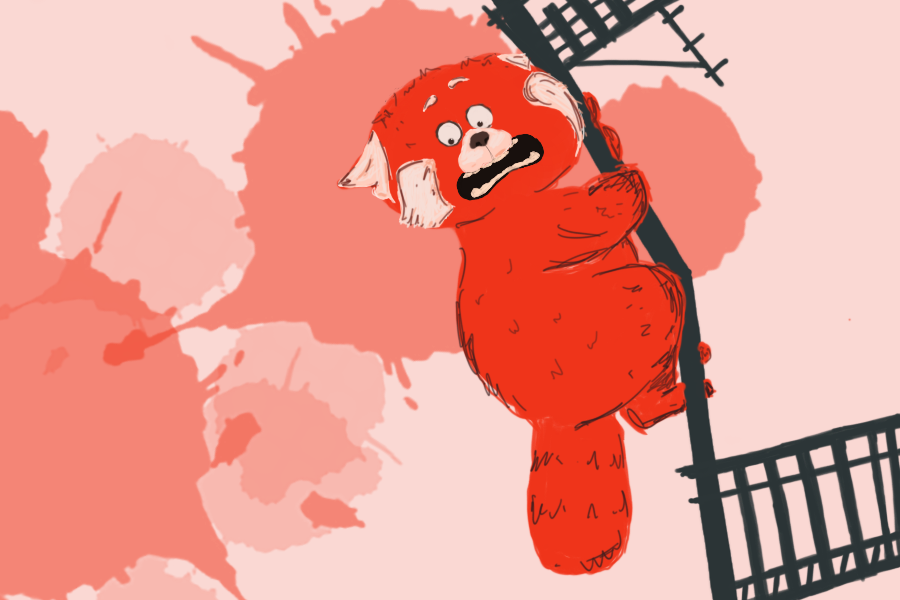Reel Thoughts: ‘Turning Red’ is an unapologetic coming-of-age ‘tail’ of self-acceptance, healing
Illustration by Audrey Hettleman
Thirteen-year-old Meilin Lee navigates Toronto as her red panda alter-ego in Pixar’s latest feature film, “Turning Red” (directed by Domee Shi).
April 7, 2022
This article contains spoilers.
Set in a dreamy rendition of early-aughts Toronto, Pixar’s new animated movie “Turning Red” captures all the angst, confusion and excitement of young teenhood.
Directed by Domee Shi (director of Pixar 2018 short “Bao”), “Turning Red” follows Chinese-Canadian teenager Meilin Lee (Rosalie Chiang) as she navigates her newfound independence. Mei helps her parents run the family temple and fangirls over the boy band 4*Town with her three best friends.
However, things get complicated when Mei starts transforming into a giant red panda whenever she feels emotional or overly excited. After learning this trait was a blessing granted to all her female ancestors, Mei struggles more than ever with her turbulent feelings. Her new alter ego forces her to confront her overprotective mother, Ming (Sandra Oh), and make her own decision about this gift.
With its vibrant cityscapes and a color palette that recalls the vivid hues of oil pastels, “Turning Red” draws clear influences from Japanese anime. Replete with Tamagotchis and Nokia flip phones, the movie brings to life what Shi (the first solo woman director of a Pixar film) dubbed the “Asian tween fever dream” of the 2000s.
“Turning Red” excels in its unapologetic depiction of girlhood and empowering female friendships. Best friends Miriam, Priya and Abby are supportive when Mei reveals her red panda form. In response to Mei’s fear they’ll “go become women without (her),” they cheer her up with 4*Town’s “Nobody Like U.” The girls’ unwavering friendships help Mei’s panda stay calm, and Mei realizes just how valuable this sisterhood is by the end of the film.
The red panda transformation is not only an allegory for puberty’s emotional and physical changes but also an avenue for the film to discuss culturally specific intergenerational trauma. In a climactic scene, Mei meets a younger version of her mother and realizes Ming had similar fears of hurting her own mother through the panda.
For those who can relate to the generational suppression of emotions or the pressures of earning parental approval, “Turning Red” may offer catharsis when Mei’s mother says “I’m sorry.”
While in our everyday lives there are no astral bamboo forests to facilitate these moments of reconciliation, this scene gives a hopeful vision of a first step — even if it’s not a thorough solution to the complexities of intergenerational trauma.
Mother-daughter relationships are a common topic in Asian diasporic media, but “Turning Red” presents a refreshing take by depicting a close and friendly dynamic between Ming and Mei from the first frame.
The beauty of the movie is the duo’s relationship shows one mother-daughter story — inevitably, it won’t align with that of every viewer, even those who also identify as Asian. “Turning Red” shows us one importance of representation: When we have more narratives about us in the media, we see the diversity of experiences in our communities.
By the film’s resolution, Mei achieves a balance between her desires to remain filial and her pursuit of other interests such as 4*Town and drawing. It’s a satisfying ending, especially when earlier scenes show this conclusion isn’t a given. Mei’s friend Miriam encourages her to keep her panda form, saying, “You’re not the same feather-dustin’, straight-A, goody-goody … you’re such a rebel now!”
Miriam’s comments reflect a perspective that doesn’t always take into consideration the complexities of Mei’s Chinese-Canadian identity. Characters and audiences may want to encourage Mei’s complete “rebellion,” viewing her loyalty to her family as a negative counterpoint. But although Mei refuses to seal her panda form away, she continues to help at the family temple, staying true to herself and all facets of her personality.
Still, “Turning Red” has its flaws. Ming uses racially coded language to deride 4*Town, describing the band with words like “delinquents,” a term often used to stereotype Black people. The movie never explicitly checks Ming on her anti-Blackness. Rather, it creates a binary between 4*Town as a vehicle for Mei’s “rebelliousness” versus her role as “a good girl.”
Especially in a film that uses Black culture and cultural contributions — music, dance, AAVE — to advance the plot, it’s disappointing to see a paucity of Black people both on screen and behind the scenes.
Hopefully, “Turning Red” can be a starting point for conversations not only about topics like intergenerational trauma but also how anti-Blackness must be addressed in both our media and our communities.
After all, conversations are what the movie is about. Along with its message of self-acceptance, “Turning Red” shows us the healing that comes when we talk to one another.
Email: [email protected]
Twitter: @aprilshowers0
RELATED STORIES:
— Reel Thoughts: Oscars Best Picture “CODA” combines coming-of-age, inclusivity
— Reel Thoughts: Fantasy and History collide in Bridgerton Season Two


